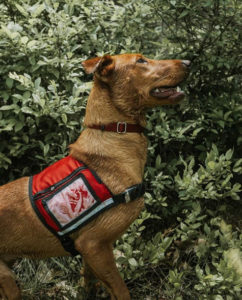K9’s Clear Invasives
 Detection dogs have long been used to sniff out drugs, explosives, cadavers and disaster survivors. In the mid ’90s, handlers started training them for conservation tasks such as sniffing out scat from endangered species and detecting trafficked ivory. Now, the olfactory prowess of detection dogs is becoming an important tool in the fight against invasive plants and insects. In 2010, the journal Invasive Plant Science and Management published a study that concluded trained dogs could smell and detect twice the number of invasive plants that humans could observe with their eyes.
Detection dogs have long been used to sniff out drugs, explosives, cadavers and disaster survivors. In the mid ’90s, handlers started training them for conservation tasks such as sniffing out scat from endangered species and detecting trafficked ivory. Now, the olfactory prowess of detection dogs is becoming an important tool in the fight against invasive plants and insects. In 2010, the journal Invasive Plant Science and Management published a study that concluded trained dogs could smell and detect twice the number of invasive plants that humans could observe with their eyes.
The Lower Hudson PRISM, hosted by the New York-New Jersey Trail Conference (NYNJTC), has deployed Dia, a spunky Labrador retriever, to hunt down Scotch broom. This species is targeted for eradication by the PRISM. Scotch broom typically grows among other plants in the fields through which the NYNJTC trails run; without the help of a detection dog, it can be difficult to spot, making Dia’s nose an important tool in efforts to control the species.
Joshua Beese, the group’s canine handler, is training and working with Dia. Josh is an emergency search and rescue dog handler for New Jersey Task Force 1 and FEMA and owner of Painted Dogz training in New York City; he is assisted by volunteer Arden Blumenthal. During their searches together, Dia wears a GPS collar to record the locations of her surveys. Once Dia detects the presence of a target species, the NYNJTC Invasives Strike Force team is called in to manage it. Over time, NYNJTC hopes to train Dia to detect multiple invasive species.
Working Dogs for Conservation, a nonprofit in Bozeman, Montana, provided mentoring for Beese as he trained Dia.
“Our field in the last 15 years has just exploded,” said Pete Coppolillo, executive director of the nonprofit. The organization partners with government agencies, researchers and nonprofits on five continents to provide trained dogs and handlers for conservation projects.
“We’ve trained over 200 dog and handler teams to help in global wildlife trafficking, and now we’re doing a lot of invasive species work,” Coppolillo said. “It’s really exciting. As ecologists we’ve always talked of invasives as something we manage, but now we may actually be able to eradicate them in some places.”
It’s doing a feasibility study in Minnesota on using detection dogs to identify trees invaded by emerald ash borers. In five Western states, dogs have been employed to detect invasive zebra and quagga mussels on boats.
To find out more about Dia and her work follow her on Instagram or visit her funding page on NYNJTC.




